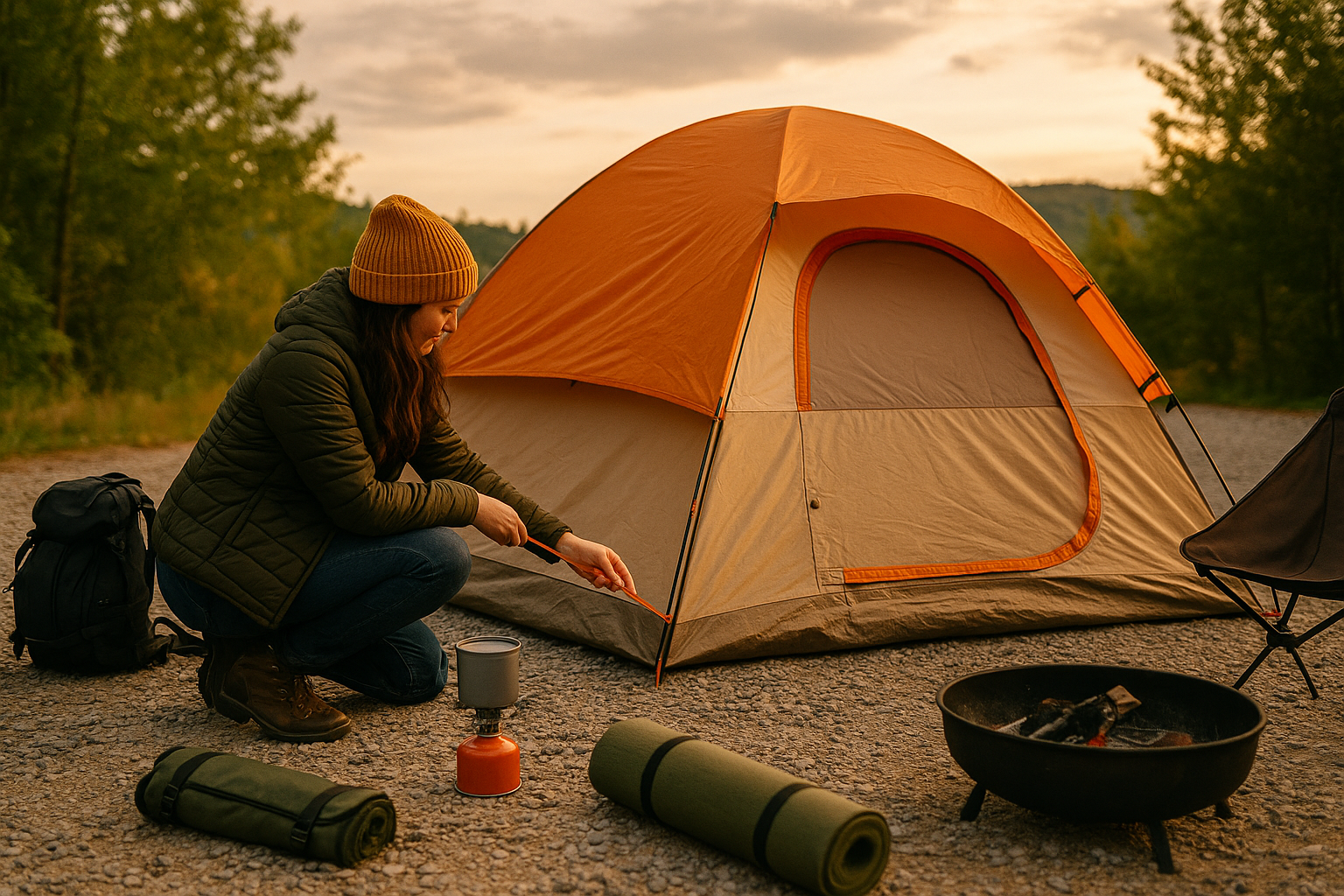Gravel looks innocent. It drains well. Keeps you out of the mud. Levels your tent pad like a pro.
But behind that clean surface is gear hell in disguise:
- Ground heat loss that eats through your sleeping bag
- Tiny tears that evolve into shredded tent floors
- Bent stakes, broken zippers, and sore backs
- And micro-abrasions that ruin even “rugged” fabrics over time
If you camp on gravel like it’s dirt, you’ll pay for it—in broken gear, wasted money, and nights of miserable sleep.
That’s why this isn’t your average “bring a tarp” tutorial. This is your smart camper’s guide to gravel survival—packed with non-obvious, field-tested tricks to keep your gear intact, your back pain-free, and your shelter rock-solid.
Let’s gear up smart and camp like gravel never stood a chance.
🔍 Step 1: Know What Gravel You’re Dealing With
Not all gravel is created equal. Before setup, assess your battlefield.
Types of Gravel You Might Encounter:
| Gravel Type | Danger Level | Notes |
|---|---|---|
| Crushed Granite | 🔴 High | Sharp edges, tears fabric quickly |
| Pea Gravel | 🟡 Medium | Round but unstable, shifts under load |
| River Rock | 🔴 High | Big, uneven, painful to sleep on |
| Compacted Road Base | 🟢 Low | Firm, flattens well—ideal with padding |
🔍 Pro Tip: Drag your hand across the site. If it feels like sandpaper or pokes your palm—reinforce everything.
🛠️ Step 2: Build a Multi-Layer Barrier—But Do It Right
Everyone says “use a tarp.” But if your tarp extends past the rainfly, it becomes a bathtub for runoff.
🔧 Smart Layering Order:
- Cleared gravel pad (remove large or sharp rocks)
- Non-slip rubber underlay (like a cut-up truck bed liner)
- High-denier footprint or heavy-duty tarp (cut slightly smaller than tent base)
- Shock-absorbing foam layer (puzzle tiles, closed-cell foam, or yoga mats)
- Optional: thin wool or felt throw (reduces friction from movement)
🧠 Genius Move: Use rubber roofing membrane scraps under high-pressure zones (under your cot or cooler legs). They’re thin, indestructible, and virtually waterproof.
🪜 Step 3: Ditch Tent Stakes—Use Anchoring Alternatives
Standard tent stakes? Useless in gravel. You’ll bend them, lose them, or curse the sky trying to get them in.
🧠 Genius Gravel Anchoring Options:
🪨 1. Deadman Anchors
- Dig a trench
- Tie guy lines to flat rocks or heavy sticks
- Bury horizontally in the gravel
- Tension lines for stability
Perfect for high winds where stakes would rip out.
🪢 2. Paracord Rock Harnesses
- Use adjustable paracord loops
- Wrap them around basketball-sized rocks
- Tension guy lines to those
Fast, reusable, no tools needed.
🧺 3. Anchor Bags
Fill small canvas or mesh bags with gravel, tie your guy lines, and use them as weighted hold-downs. Especially great for dome tents or vestibule extensions.
🛠 Pro Tip: Keep a roll of duct tape and zip ties on hand. If your pole anchors shift, you can create gravel tension triangles with minimal gear.
🏗️ Step 4: Elevate, Insulate, and Isolate
Gravel is cold and unforgiving. You want to stay above it, not just on it.
🔥 Use These Underrated Elevation Hacks:
🧶 1. Modular Foam Tiles (Puzzle Mats)
Create a customizable, insulative floor that cushions your sleep system.
- Use a checkerboard layout to reduce movement
- Double layer under hips or sleeping pad pressure points
🛏 2. Build a Mini Pallet Floor
Got a few 2x4s or camp with a trailer? Build a slatted base and throw a rug or mat on top. Zero rock contact.
🧊 3. Insulation Mats from Car Windshield Reflectors
Cut them up and place between the tarp and your pad—blocks cold transfer like a boss.
📦 4. Pack Flattened Cardboard Boxes
Use as an underlayer beneath your tarp for unexpected cushioning. Cheap, biodegradable, surprisingly effective.
🧽 Step 5: Keep Dust and Gravel OUT of Your Tent
Gravel campsites create abrasive micro-dust that sneaks into your tent and slowly shreds fabric from the inside out.
🚪 Set Up a Dirt Defense Zone:
| Tool | Use |
|---|---|
| Doormat | Outside tent to wipe boots |
| Small Broom | Sweep tent daily (yes, daily) |
| Dedicated camp shoes | No gravel boots in the tent |
| Under-tent skirt | Attach fabric around tent base to deflect debris and dust |
🧼 Pro Tip: Use an old microfiber towel to wipe off your back or sleeping pad—especially if you sit outside directly on the gravel. Every speck matters.
🔗 Step 6: Reinforce High-Wear Zones Before They Rip
Every tent has wear zones—corners, vestibule door entry, under air mattress valves, etc. On gravel, these are guaranteed failure points if ignored.
🧠 Preemptive Protection Moves:
🧵 A. Apply Tenacious Tape to Inner Tent Corners
Do this before your trip—not after a rip. Add double-layer strips on the inside floor corners and under the zipper line.
📏 B. Add Mini-Mats Under Pressure Points
Wherever you walk or place weight—add double foam or rubber there.
🎒 C. Use Gear Hammocks or Tent Loft Nets
Keep heavy gear off the floor entirely—reduce gravel abrasion risk dramatically.
🛠️ Bonus: Use peel-and-stick neoprene pads (found in automotive sections) under sleeping pad contact zones for zero-slip + cushioning.
🔇 Step 7: Silence the Creak, Crunch, and Crackle
Gravel tents are LOUD at night—pads creak, foam shifts, pebbles crunch under pressure. If stealth or sanity matters, fix it.
🧠 Silent Camping Tricks:
- Use wool blankets or military surplus wool liners under noisy pads
- Sprinkle baby powder or camp chalk between tarp and foam to reduce squeak
- Secure edges of tarp with Velcro + stake ties to prevent flapping or shifting
🔇 Pro Tip: Silicone spray lightly misted on plastic ground tarp reduces friction noise when rolling over in sleep.
🚨 Bonus: Emergency Gravel Fixes
Forgot your tarp? Lost your mat? Here’s what to do in a pinch:
🪵 1. Pine Bough Bed Layer
Lay pine or fir boughs directly under the tent footprint. Adds elevation, insulation, and padding.
📰 2. Newspaper or Cardboard Layering
Stacked newspaper sheets or cardboard (yes, even from food packaging) can add thermal buffer and ground padding in seconds.
🗑️ 3. Garbage Bag + Clothing Pad
Stuff your extra clothes into a trash bag and lay it under your sleeping pad for instant insulation.
🎒 Smart Packing List for Gravel Tent Camping
| Item | Why You Need It |
|---|---|
| Heavy-duty tarp or footprint | Barrier against sharp gravel |
| Interlocking foam tiles | Cushion and insulation |
| Rubber mat or truck liner scrap | High-abrasion protection |
| Small broom or tent brush | Daily grit cleanup |
| Rock-friendly tent anchors | Holds up in loose surfaces |
| Duct tape & Tenacious Tape | Field repairs and pre-reinforcement |
| Paracord + zip ties | Emergency guy line fixes |
| Military surplus wool blanket | Quiet, insulating, bombproof |
🏁 Final Words: Don’t Just Camp on Gravel—Dominate It
Anyone can survive a gravel campsite for one night.
But smart campers don’t just survive—they set up like pros and rest like kings. They don’t settle for a tarp and prayer. They engineer a floor system. Reinforce stress points. Eliminate squeaks. They leave no detail to chance.
Gravel might look like a basic, no-mud solution—but it’s got claws. With these ingenious hacks and not-so-obvious fixes, your tent stays intact, your sleep stays solid, and your gear stays ready for the next trip—not the trash bin.
Because out here, your comfort isn’t luxury—it’s tactical advantage.

